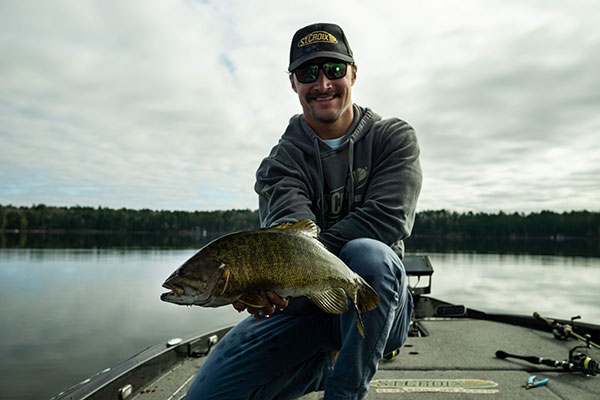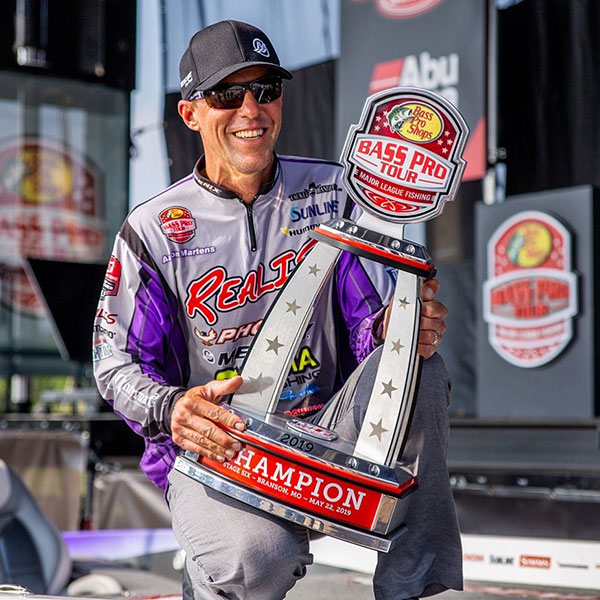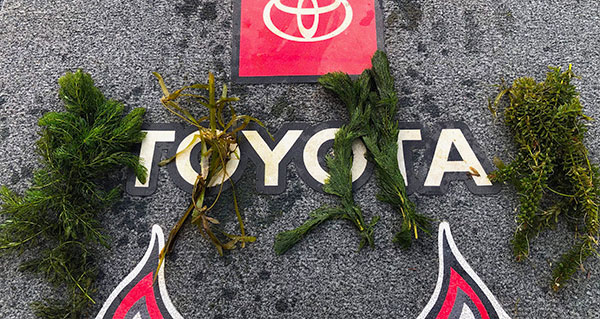- Details
By Josh Lantz, Traditions Media
 Cody Hahner of Wausau, Wisconsin with a nice smallmouth
Cody Hahner of Wausau, Wisconsin with a nice smallmouth
For most bass anglers, crankbaits are just flat-out fun to fish. Designed to fish on a constant (or near-constant) retrieve while maintaining contact with and deflecting off structure, crankbaits provide the angler with tons of feedback.
“The main reason I like it is because you’re actively cranking and you’re feeling what the bait is doing the whole time,” says Addison, Alabama tournament angler and MLF competitor, Jesse Wiggins. “You feel exactly what that bottom or piece of structure is, and there’s no mistaking when the fish actually eats the bait. Plus, crankbaits help you cover a lot of water.”
FLW pro and northern river specialist, Cody Hahner of Wausau, Wisconsin, agrees. “Crankbait fishing is one of the more exciting ways to fish. It’s an amazing way to cover water for sure, but what’s more important to me is how I’m able to feel the bottom and the contours of the structure,” he says. “I can feel the sweet spots and I can feel how a crankbait reacts over certain types of structure. I’m not partial to any hard bait brand, so I can say openly that every crankbait reacts differently to the type of structure you fish. You could line up four crankbaits that all run four feet deep, but one will work best in gravel, one in sand to rock, one in timber, and one in busted concrete. It’s almost like finding the right soft plastic for the current situation. At this time of year, I’ll have at least 5 different crankbaits on my deck.”
For Hahner, “this time of year” – late September through October – is his absolute favorite time to throw a crankbait for river smallmouth. “In the north country our summer is over and the fall transition is in full swing. The first major cold snap will cause river smallmouth to get fidgety and begin the move to their winter pools,” he says. “Much like us northerners gathering firewood, these smallmouth are preparing to deal with winter, too.”
- Details
By Clay Gaillard, Mercury Report
 Aaron Martens
Aaron Martens
It’s tempting to think of Aaron Martens as an unlucky guy.
The Mercury Pro Team member has finished second in the Bassmaster Classic a record four times, after all, and has never walked away with the crown. Once he missed it by the weight of a modest hamburger patty.
Then, of course, he had a massive seizure while fishing in the spring of 2020, which revealed the presence of two brain tumors. Since then, Martens has had two brain surgeries and has endured almost constant chemotherapy for a year and a half.
Yeah, he’s had some hard days.
But if that’s all you see, you’re most assuredly missing a lot.
By any measure, Martens, 49, of Leeds, Alabama, is among the most accomplished bass anglers of this or just about any generation. True, he’s famously come up just short at one of the sport’s single biggest tournaments four times, but that also means four times he’s traded blows with the other giants of the sport atop the Classic leaderboard, a spot most elite anglers dream of being in just once in a career. And if you’re concerned about a lack of titles, rest assured he’s got those, too. Besides being a three-time champion of the prestigious WON BASS U.S. Open tournament, he also earned the title of Bassmaster Angler of the Year in 2005, 2013 and 2015.
If that makes him lucky, so be it. But Martens has the kind of luck that comes from putting in the work, and one could argue that it’s that kind of fortitude that makes him uniquely positioned to conquer glioblastoma, one of the toughest-to-fight cancers that’s ever cursed our species.
- Details
By Al McGuckin
 Aquatic vegetation coontail, eel grass, milfoil, and hydrilla
Aquatic vegetation coontail, eel grass, milfoil, and hydrilla
For anglers not used to picking apart coontail, eel grass, milfoil, and hydrilla, as shown from left to right in the attached photo, approaching massive acres of aquatic vegetation can be as intimidating as a high school quarterback walking into an NFL stadium full of fired-up fans.
Team Toyota’s Brandon Lester has made a detailed study of how to pluck bass from grass en route to winning $800,000 thus far in his short pro career. And he graciously shares a look at his playbook in timely fashion as early fall often begins the best ‘grass fishing’ of the year.
A garden variety is best
To the casual observer with an untrained eye, expansive acres of matted vegetation might all look the same. Look closer at a place like iconic Lake Guntersville and you’ll see coontail, eel grass, milfoil, and hydrilla often mixed together like Olive Garden’s famous house salad.
“Anytime you see three or four species of vegetation growing together, I can almost assure you that’s going to be a great place to get bites. In fact, you need to look for places where one kind of grass marries up against the other to form a sort of a transition, that’s the juice,” grins Lester.





